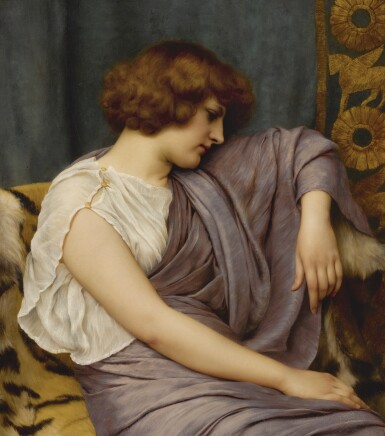
Property from a Private West Coast Collection
JOHN WILLIAM GODWARD, R.B.A. | BRISEIS
Auction Closed
May 22, 03:43 PM GMT
Estimate
250,000 - 350,000 USD
Lot Details
Description
JOHN WILLIAM GODWARD, R.B.A.
British
1861 - 1922
BRISEIS
indistinctly signed J.W. GODWARD and dated 96 (upper right)
oil on canvas
32¾ by 28¾ in.
83.2 by 73 cm
Thomas McLean, London (acquired directly from the artist, 1896)
Sale: Christie's, London, July 1, 1905, lot 92
Thomas McLean, London (acquired at the above sale)
Sale: Christie's, London, October 21, 1955, lot 117
Manuel Cervantes, Mexico City (acquired at the above sale)
Private Collection, Los Angeles (by descent from the above)
Page Art, Inc., Costa Mesa, California
Acquired from the above in 2009
London, Thomas McLean, 32nd Annual Exhibition, 1896, no. 23
Vern G. Swanson, John William Godward, The Eclipse of Classicism, Woodbridge, 1997, p. 193, no. 1896.3
Vern G. Swanson, J.W. Godward 1861-1922, The Eclipse of Classicism, Woodbridge, 2018, p. 273, no. 1896.3
By 1896, the year the present lot was completed, John William Godward had begun to name his classical models after important women of Greek and Roman history, literature and mythology. Though his figures were often depicted idling away long afternoons on Mediterranean terraces or in lavish marble interiors, names such as Andromeda and Campaspe connected them to a historical narrative. Briseis is described in Homer’s Iliad as the wife of King Mynes of Lyrnessus, who was celebrated for her beauty, though her story was marked by tragedy. Her town was an ally of Troy and, after it fell to Achilles and his troops, Briseis was taken as his concubine. Briseis famously came between Achilles and the King of Mycenae, Agamemnon, who demanded that Briseis become his own concubine, almost costing the Greeks their campaign in the war. Briseis was a decisive character in the Trojan War, and an apt heroine for Godward to depict.
Briseis is a showcase for Godward’s idyllic, classical world, from the exotic tiger skin and translucent white tunic to the woven tapestry in blue and gold featuring rosettes and Pegasus. While Briseis is far removed from the battlefield, there is a hint of melancholy in her downcast and contemplative gaze. From the Renaissance to the nineteenth century, Briseis is often depicted at the most dramatic moments of her story—either being taken from Achilles’ tent or mourning the death of his friend Patroclus— while Godward’s painting provides a more intimate view of the Trojan heroine.
The model in Briseis is Rose Amy Pettigrew, who began posing for Godward in 1887. Along with her sisters Harriet (Hetty) and Lily, she modeled for some of the best-known artists in London, among them James McNeill Whistler, John Singer Sargent, William Holman Hunt, Philip Wilson Steer, and John Everett Millais. The sisters were the most highly sought-after models in London because they had a very distinctive, pre-Raphaelite look (Swanson, 2018, p. 204). Rose Amy continued to model for Godward until she married Harry Waldo Warner (1874-1945), a famous violinist and composer, in 1896.
